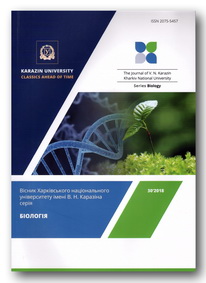The flora of the botanical preserve “Honcharivskyi” (Luhansk Region, Ukraine)
Abstract
The current state of the flora of the botanical preserve “Honcharivskyi” (Svatove District, Luhansk Region) is analysed. The preserve includes three areas on the right-bank slopes of the Kobylka and the Krasna rivers with outcrops of chalk bedrocks. The study was conducted in summer and autumn 2019. Four expeditionary trips were organized to the areas near the villages of Oborotnivka and Nauholne. Floristic descriptions made by the line-transect method saved as research material. Identification of floristic composition was carried out by the plant species inventory along the transects. As a result, an annotated list of 85 species of vascular plants of 74 genera, 29 families, 3 classes and 2 divisions was compiled. In terms of systematic composition, the spectrum of main families is headed by Asteraceae (22 species, 25.9 % of the flora), Poaceae (9 species, 10.6 %), and Lamiaceae 7 (species, 8.2 %). These families include a significant number of ruderal, steppe and calcephilous species. Hemicryptophytes, represented by herbaceous plants of steppe meadows, prevail in the flora biomorphic structure (51 species, 60 %). Chamaephytes (in our case study the subshrubs, growing on steppe slopes, chalk and limestone outcrops, viz., Genista tinctoria L., Hyssopus cretaceus Dubjan., Teucrium polium L. etc.) are least presented (6 species, 7.1 %). A cenomorph analysis revealed predominance of the ruderal species (35; 41.2 %) due to grazing, trampling and economic activity in the study area. The flora ecological analysis was based on five main factors, which reflect climate and soil properties. In terms of soil acidity, the neutrophilic species formed a dominating group (53 species, 63 %), in terms of carbonate compounds – the acarbonatophilic (34 species, 40 %), in terms of soil salinity – the eutrophytic (36 species, 43 %), in terms of climate thermal regime – the sub-mesothermic (59 species, 70 %), and in terms of climate continentality – the hemicontinental ones (43 species, 52 %). Most recorded species prefer slightly acidic and/or neutral, rich in salts and carbonates, meadow like and common chernozems of steppe meadows and steppes. Twelve species of 11 genera and 7 families are of conservation concern. Of these, 10 species are listed in Red Data Book of Ukraine, five species are in the European Red List of Vascular Plants (Hyssopus cretaceus Dubjan., Artemisia hololeuca M. Bieb. ex Besser, Centaurea donetzica Klok., Cephalaria litvinivii Bobr., Hedysarum cretaceum Fisch.), and two species are in the Red List of plants of Lugansk Region (Thymus calcareus Klokov & Des.-Shost. and Potentilla erecta (L.) Raeusch.).
Downloads
References
Borozenets V.A., Tikhonyuk P.S. (2000). Reserved Luhansk region. Luhansk. 91 p.
Burda R.I. (1991). Anthropogenic transformation of flora. Kiev: Naukova Dumka. P. 16–19.
Chusova O.O. (2019). Vegetation and biotopes of the Krasna River basin. Abstract of the thesis for the Degree of the Cand. Biol. Sciences. Kyiv. 20 p.
Didukh Ya.P. (2011). The ecological scales for the species of Ukrainian flora and their use in synphytoindication. Kyiv: Phytosociocentre. 176 p.
Didukh Ya.P., Chusova O.O. (2014). Rare xerophytic steppe plant communities and biotopes in the Krasna river valley (Lugansk region). Ukrainian Botanical Journal, 71(3), 275–285. https://doi.org/10.15407/ukrbotj71.03.275.
Dobrochaeva D.N., Kotov M.I., Prokudin Yu.N. et al. (1987). The determinant of higher plants of Ukraine. Kiev: Naukova Dumka. 548 p.
Eco-network of the steppe zone of Ukraine: principles of creation, structure, elements. (2013). Kyiv: LAT&K. 409 p.
Isaeva R.Ya., Kuznetsova P.І., Lutsenko A.І. et al. (1999). Steppe diversity of Luhansk region in the sozological aspect. Ukrainian Botanical Journal, 56(1), 10–14.
Konoplya O.M., Isaeva R.Ya., Konoplya M.I., Ostapko V.M. (2003). Rare and endangered plants of Luhansk region. Donetsk: UkrNTEK. 340 p.
Nature Reserve Fund of Luhansk Region. (2008). O.A. Arapov, T.V. Sova, V.B. Ferents, O.Yu. Іvanchenko (Ed.). Luhansk: OJSC "LOD". 168 p.
Official lists of regional rare plants of administrative territories of Ukraine (reference book). (2012). Compiled by T.L. Andrienko, M.M. Peregrym. Kyiv: Alterpress. 148 p.
Peregrym M.M. (2006). Rare and endangered species of flora of the Donetsk ridge. Abstract of the thesis for the Degree of the Cand. Biol. Sciences. Kyiv. 19 p.
Red Data Book of Ukraine. Vegetable Kingdom. (2009). Ya.P. Didukh (ed.). Kyiv: Globalconsulting. 912 p.
Serebryakov I.G. (1964). Life forms of higher plants and their study. In: Field Geobotany. Moskow, Leningrad: Nauka. Vol.3. P. 146–205.
The IUCN Red List of Threatened Species. Version 2020-2. https://www.iucnredlist.org. (downloaded 09.07.2020)
Tolmachev A.I. (1974). Introduction to plant geography. Leningrad. 244 p.
Vegetation of the USSR. Steppes, rocky outcrops, sands. (1973). A.І. Barbarych (ed.). Kyiv: Naukova Dumka. 428 p.
Authors retain copyright of their work and grant the journal the right of its first publication under the terms of the Creative Commons Attribution License 4.0 International (CC BY 4.0), that allows others to share the work with an acknowledgement of the work's authorship.




